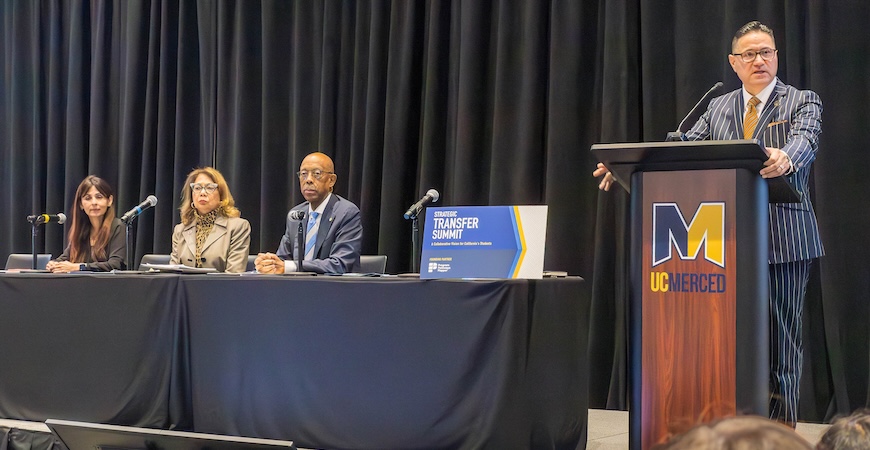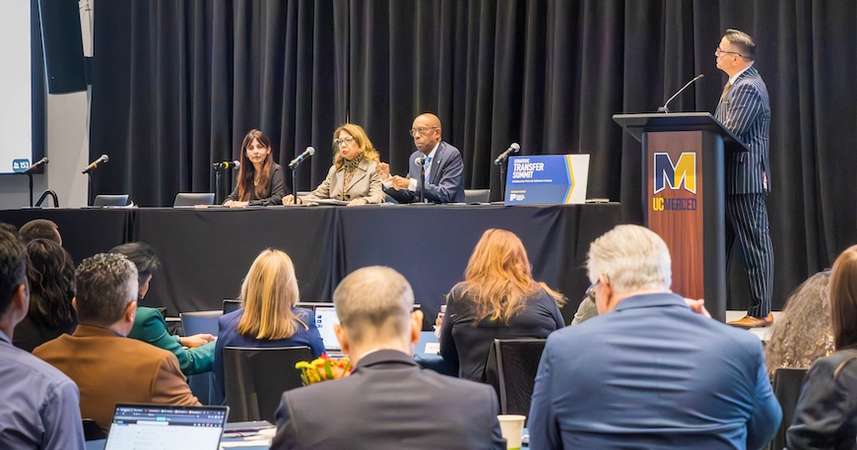
Between 70% and 80% of students who start classes at community colleges plan to transfer to four-year universities. But only between 20% and 30% do.
In California, that number is closer to the lower end of that spectrum, a University of Wisconsin researcher told a room full of higher education representatives.
The leaders of California's three public higher education systems were among the attendees at the inaugural Strategic Transfer Summit, hosted at UC Merced in early November. The summit was aimed at highlighting the challenges students face in transferring from community colleges to four-year universities, and at finding ways to reduce or eliminate those hurdles.
"Students have to navigate multiple programs to transfer," said Xueli Wang, educational leadership professor at the University of Wisconsin-Madison. "They find themselves wandering around the educational system."
Her research found that students failed to transfer to four-year colleges for a variety of reasons, including financial needs, loss of credits between institutions, family considerations and social isolation. She advocated a holistic approach, addressing all these issues, stabilizing institutional structures and "uncluttering" the path for these students.
Several current and former transfer students described their experiences making the transition to four-year universities.
"It was a little confusing," said Sebastian Lepe, who attends California State University, Stanislaus. But Lepe, a first-generation college student, said he had helpful professors at Hartnell College in Salinas. "They guided me into what classes I needed to take and pushed me, saying, 'Hey, this is what you've got to do.'"
Others didn't get the same level of guidance.
"My advisor said, 'What is this major?'" said Michael Schultz, a cognitive science student at UC Merced who attended Modesto Junior College. "I looked at the UC Merced website and had to go through that all by myself."

During the summit, UC Merced Chancellor Juan Sánchez Muñoz moderated a panel featuring California Community Colleges Chancellor Sonya Christian, University of California President Michael Drake and California State University Chancellor Mildred Garcia.
"We're all working toward a common pathway for K-12 students to complete a baccalaureate and beyond," Muñoz said. "We are working on a structure for the realization of that dream."
The leaders talked about what their institutions already are doing and have planned to ease the path for transfer students.
"We have to understand our students," Garcia said. "Our institutions are starting to seek what is it our students want to do."
Drake, who like Garcia began his college career at a community college, said one of the hurdles is the wide variety of majors available to incoming students. While the increase in offerings is overall a positive development, Drake said it can make navigating the system more difficult.
"The challenge that we have is to take the benefit of the dramatic number of choices students have and streamline that in a way that someone coming into the system can understand it," he said.
Creative approaches are helping. Drake highlighted a pilot program at UCLA to work with community colleges that don't have high-transferring student populations. Christian noted programs such as UC Merced's Promise, which created a streamlined transfer process for students from community colleges that enter into agreements with the university.
Garcia pointed to Placer Center, a joint project of Sacramento State University and Sierra College that offers classes from both campuses in a shared learning space for 12,000 students.
"It's the first 'communiversity' in California," she said. "Those are the kind of partnerships we should have."
The growth in ADTs, or Associate's Degrees for Transfer, also is helping. These two-year degrees provide students with fully transferrable credits and a guaranteed admission to a four-year university. Students pursuing these degrees get advising and guidance throughout their educational careers.
"We're using the ADT to go after those students," Garcia said. "Sometimes if we call the student and they say they'd rather go to a UC, we need to make sure they get the connections they need.
"That's the collaboration we need to strengthen."

